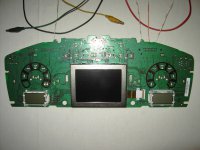have a question about the LCD screens used on the abarth clocks (the ones to display time and mileage)
since removing them and changing the led from orange to white i have dead segments on each display... in my haste and frustration i have stupidly pulled 5 of the pins off the clock display but oh what little i do know about LCDs, arent they just friction connected anyway?
the mileage display survived unscathed but still has dead segments. my soldering is usually spot on and im 99% sure theres nothing wrong with my connections from leg to board.
i have 2 scenarios... ive either used too much heat and managed to burn the inserts from the board or the resistance is wrong in the circuit due to the different LEDs.
since removing them and changing the led from orange to white i have dead segments on each display... in my haste and frustration i have stupidly pulled 5 of the pins off the clock display but oh what little i do know about LCDs, arent they just friction connected anyway?
the mileage display survived unscathed but still has dead segments. my soldering is usually spot on and im 99% sure theres nothing wrong with my connections from leg to board.
i have 2 scenarios... ive either used too much heat and managed to burn the inserts from the board or the resistance is wrong in the circuit due to the different LEDs.


